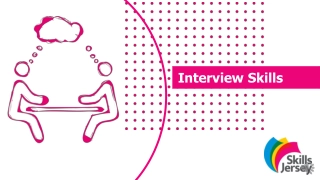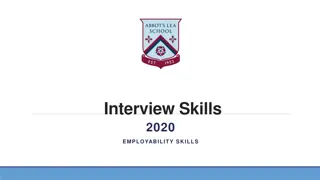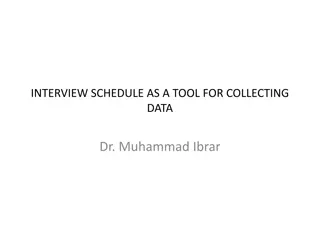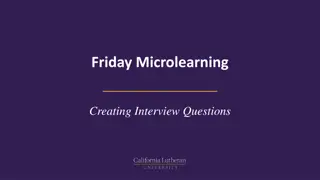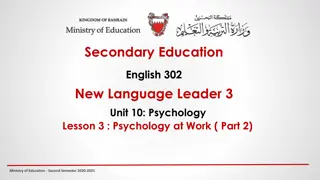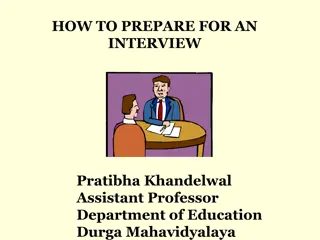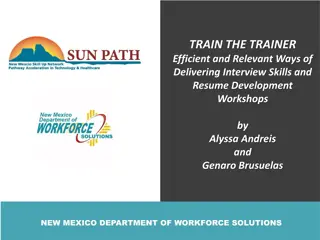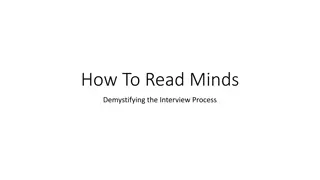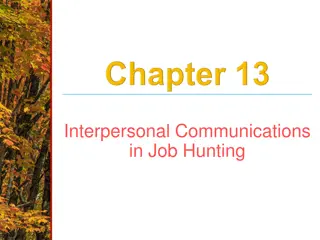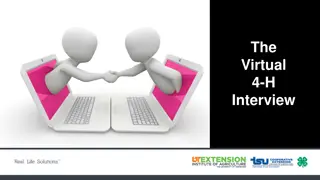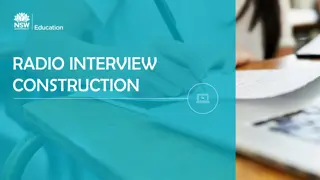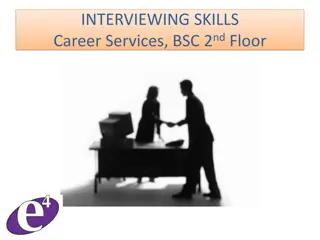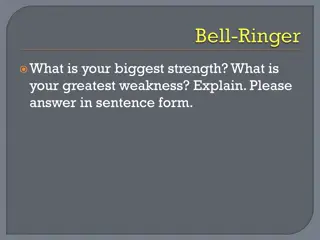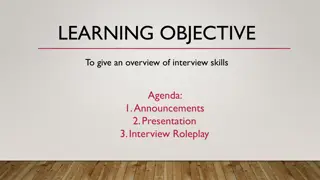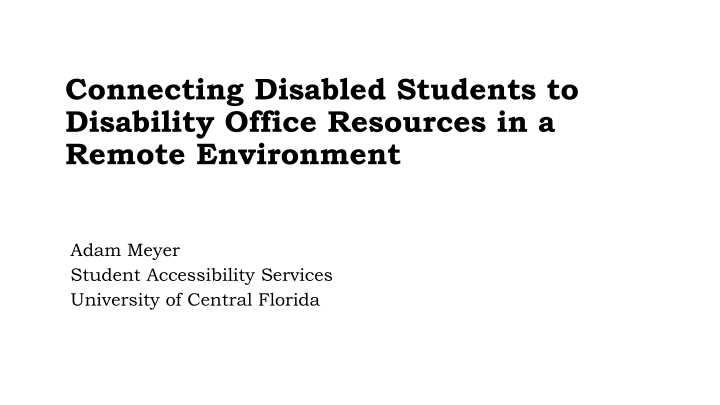
Enhancing Accessibility for Disabled Students in Remote Education Environment
Discover how to connect disabled students to disability office resources in a remote environment, ensuring equal access and eliminating barriers. Learn about common college environment obstacles and the importance of providing inclusive services for disabled individuals.
Download Presentation

Please find below an Image/Link to download the presentation.
The content on the website is provided AS IS for your information and personal use only. It may not be sold, licensed, or shared on other websites without obtaining consent from the author. If you encounter any issues during the download, it is possible that the publisher has removed the file from their server.
You are allowed to download the files provided on this website for personal or commercial use, subject to the condition that they are used lawfully. All files are the property of their respective owners.
The content on the website is provided AS IS for your information and personal use only. It may not be sold, licensed, or shared on other websites without obtaining consent from the author.
E N D
Presentation Transcript
Connecting Disabled Students to Disability Office Resources in a Remote Environment Adam Meyer Student Accessibility Services University of Central Florida
The only way to make sense out of change is to plunge into it, move with it and join the dance. -- Alan Watts
Begin with the End in Mind Begin with the End in Mind Why do we do the work that we do? ACCESS But what does that mean exactly?
What is the goal of access? What is the goal of access? To eliminate discrimination on the basis of disability Cannot be excluded from participation in or be denied the benefits of any program, activity, aid, benefit or service Must provide an opportunity to participate in or benefit from a service that is equal to or as effective as that provided to others Cannot provide different or separate aid, benefits, or services unless such action is necessary to provide disabled people with aid, benefits, or services that are as effective as those provided to others; Must afford equal opportunity to obtain the same result, to gain the same benefit, or to reach the same level of achievement, in the most integrated setting appropriate to the person's needs.
Equal Access Means No Barriers Equal Access Means No Barriers Disabled students experience equal access when they are able to: Fully engage and participate in the same activities; Utilize the same information shared with everyone; Have the same opportunity to achieve; Enjoy the same campus services, benefits and experiences as a person without a disability.
Common College Environment Barriers Common College Environment Barriers Poor physical space and design Communication, Engagement and Interaction Captioning Class presentations Small groups Expectations of meeting with professors and staff Inaccessible electronic and digital information Time Space distractions Attitudes and lack of awareness Reading and writing demands Disability office practices Policies What else??
Where is the disability and barrier intersection? Where is the disability and barrier intersection? We facilitate access and accommodations at the point where disability intersects with academic barriers Student with learning disability does not have adequate time for a 60-minute exam Deaf student needs captioning for videos Student with chronic health condition misses 3 4 classes per semester, which intersects with course attendance policies
Barriers Fluctuate by Class Barriers Fluctuate by Class Numerous content delivery approaches Exam formats differ Courses may or may not include videos Attendance policies vary Wide array of assignments
No matter the academic environment we are working within, the goal is to remove barriers by facilitating equal access.
Two Essential Steps to Facilitating Access Two Essential Steps to Facilitating Access 1. Develop a clear understanding of how disability impacts the individual Such that a specific accommodation is reasonable relative to the individual s situation and experience 2. Determine whether the accommodation is reasonable within the academic context
Goal of Initial Meeting Goal of Initial Meeting Establish that the student has a disability that substantially limits one or major life activities Understand how the condition impacts the student at the current time and in the current circumstances while also assessing future impact Assess the extent to which the student experiences the loss or limitation of opportunities to take part in the academic experience on an equal level with others due to physical, social, procedural, electronic/digital and attitudinal barriers
AHEAD Guidance on Documentation Practices AHEAD Guidance on Documentation Practices PRIMARY --- Talk to the student as the first, initial step in the process (not always a heavier focus but always a first focus) SECONDARY --- What do you, the professional, assess from your point of view? TERTIARY --- Bring in additional outside information as needed to close any gaps in the decision-making process.
Thoughts on Documentation Guidance Thoughts on Documentation Guidance ADA and 504 do not require 3rdparty documentation Our goal is to determine that the student is impacted in a major life activity, not to determine the presence of a specific diagnosis/label Our notes from student conversation serve as important documentation
Consistency is found in the internal office process, not in the presence of 3rdparty documentation Consider what additional 3rdparty documentation would make if received What gaps would it fill in your understanding? Will it truly provide any additional information beyond what you have/know? During this COVID-19 period, you may need to consider a documentation approach different from what you generally do or prefer
It is often possible to evaluate whether a requested accommodation is reasonable or not with minimal reliance on external documentation. This is true even if the student has never received formal accommodations or recently acquired a disability and is seeking guidance to determine accommodations that might be effective. However, if the student is unable to clearly describe how the disability is connected to a barrier and how the accommodation would provide access, the institution may need to request third party documentation focused on illustrating that connection. (From AHEAD Guidance on Documentation)
Determining accommodations in distinctly new contexts may require more focused information to illustrate a connection between the impact of the disability, the described barrier, and the requested accommodation. (From AHEAD Guidance on Documentation)
Never Waste a Question Never Waste a Question The questions we ask students and how we ask them will greatly influence the information that we receive Goal is to determine the student s disability, history, experience, request, and the unique characteristics of the course, program, or requirement in order to determine whether or not a specific accommodation is reasonable. May need to assess direct experience and barriers with online work more so than previously done
Questions to Assist in Facilitating Conversation Questions to Assist in Facilitating Conversation What brought you here today? What environments create barriers/challenges for you? Are you most successful? What barriers/challenges in the classroom or otherwise are you experiencing currently? How does X experience impact you? What type of classroom environment do you prefer? What solutions have worked in the past? What solutions might work in this situation based on your assessment? What kind of exams or assessments work well for you? What is it about Y test (class, paper, etc.) that meant you didn t need accommodations for it? What types of assignments do you enjoy? What types of assignments challenge you? What accommodations did you use in high school?
Possible Questions Related to Online Learning Possible Questions Related to Online Learning What do you like about the online learning experience? What has been more challenging thus far for you in learning and doing assessments online compared to face-to-face classes? What has been your experience (based on information being shared) Doing tests online? Watching videos? Participating in online chats? Managing and navigating the various online course design arrangements? Are you noticing more academic barriers/challenges in the online setting compared to traditional face-to-face? What is creating the difference if so? Is there a reason that prompted you to reach out to us now specifically during this remote learning time?
Goal of Initial Meeting Goal of Initial Meeting Establish that the student has a disability that substantially limits one or major life activities Understand how the condition impacts the student at the current time and in the current circumstances while also assessing future impact Assess the extent to which the student experiences the loss or limitation of opportunities to take part in the academic experience on an equal level with others due to physical, social, procedural, electronic/digital and attitudinal barriers
Accommodations Accommodations Should B Barriers arriers Should R Remove Academic emove Academic Does the considered accommodation remove an actual academic barrier? Does the accommodation seem reasonable at face value? Does it pass the smell test ? When is it our responsibility to remove the barrier with an accommodation? When is it the student s responsibility to manage and address internal barriers and personal behaviors or challenges?
Disability Barrier vs. Personal Challenges Disability Barrier vs. Personal Challenges Possible Personal Challenges (That the Student May Need to Figure Out) I am anxious that I will not have enough time because this is a new experience for me. I do not like the online test format and prefer to take tests on paper. I am having difficulty managing my time and staying focused to get the work done by deadline. Possible Disability-Design Barrier (Warranting Accommodations) Not enough time to complete exams due to disability and time limit intersection. Something about the exam format is a legitimate barrier (such as not accessible to screen reader). The amount of time available to complete assignments is a legitimate barrier.
Possible Professional Judgment Consideration Possible Professional Judgment Consideration during this Remote Period during this Remote Period Is what the student is describing something that Many/most/every student may be experiencing during this remote experience? Unique to the specific disability in conjunction with the course design and related academic barriers? Examples: Proctor Hub No revisiting test questions Meeting course chatroom requirements Posting video responses Increase anxiety because of stress related to COVID-19
Online vs. Face Online vs. Face- -to to- -Face Accommodations Face Accommodations What if the barriers are only for online courses and not for face-to- face? What does such a difference look like from a disability perspective? Would you consider only providing accommodations for online courses and not face-to-face? Tailor the accommodation to fit the specific relevant situation?
Accommodation Considerations for Accommodation Considerations for COVID COVID- -19 Specific Situations 19 Specific Situations Are students who never approached the disability office before but are stressed BECAUSE of the coronavirus entitled to accommodations? What about students who already use accommodations but now have additional requests because of anxiety associated with COVID-19? How do we handle faculty who are referring students to the disability office because they don t know where else to refer the student? What about a student who is specifically diagnosed with COVID-19?
Possible Decision Possible Decision- -Making Guidance Making Guidance Is there a legitimate need for access or accommodations due to a substantial limit in a major life activity? (Possible discrimination?) What accommodation is specifically sought? What does the student say would be an ideal solution for the concern? Is the requested accommodation reasonable relative to the identified disability? Would the ideal solution address an academic barrier or a personal challenge? Would a possible accommodation remove an academic barrier or simply extent the impact of a personal challenge? Is this accommodation reasonable within the context of the course experience?
Consider Asking Students Info in Advance Consider Asking Students Info in Advance What information can be gathered prior to meeting? Could the student complete information before scheduling the appointment? Primes the student for the meeting to come Allows some initial preparation
Using Remote Formats and Overall Impact Using Remote Formats and Overall Impact Give the student an option of phone or video chat? Does your conversation flow differ if using phone or video chat? Offer the student a practice connection session prior to meeting? What challenges exist for you as the professional in using a means other than face-to-face? How does the loss of direct non-verbals and behavior observation come into play? May need to ask a few more questions to close the gap May need to take time to consider requests and ask follow-up questions later
Does anything about your meeting rhythm from start to finish need to be adjusted? What is easier to do in person that feels different remotely? How do the steps communicated to students differ? How will time and experience make the process more manageable or even on par with in-person meetings?
Can be harder to build rapport where student feels comfortable following up as future issues arise The initial meeting is the first step in an on-going process Need to confirm who is in attendance for the virtual meeting? Benefit to student having computer access during meeting to review specific websites?
Are students getting/processing the information the first time communicated? Use follow-up emails and website as information tools Processes and habits students using today may not fit when return to campus (Ex: accommodated test scheduling processes) Consider inviting students to a follow-up meeting or office open house when return to campus
Learn About the Remote Course Design (and Learn About the Remote Course Design (and Barriers) where Possible Barriers) where Possible How is your campus approaching the remote learning period? Is synchronous learning common or is it mostly asynchronous? What are common test formats and approaches? How much time do students have to complete assignments? What is the degree of video use in classes? How long will this time last on your campus? If this goes from short-term to longer-term, how will the campus evolve in its thinking of and delivery of online learning?
Use this Time to Make Enhancements Use this Time to Make Enhancements How can this time be used to thoughtfully think through the initial meeting process? Where may forced changes in this period benefit the system overall long-term? Questions to students Use of third party documentation Way to assess reasonableness of initial accommodation requests There is a chance we will do this all year or again in the fall.
Questions? Thoughts? Agree or Disagree?

